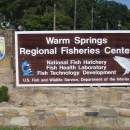The Cryopreservation Lab at Warm Springs Fish Technology Center develops cryopreservation techniques to support fisheries conservation across the Service and for our partners.
Cryopreservation is a process in which a living cell can be frozen, stored, thawed, and remain viable for future growth. The cryopreservation lab at Warm Springs Fish Technology Center focuses on developing and implementing cryopreservation techniques to secure the remaining genetic diversity of endangered species, reduce issues caused by non-coincident mating, improve control in artificial spawning programs, and transfer wild genetics into hatchery stocks.
Conservation Benefits of Cryopreservation
The U.S. Fish and Wildlife Service’s Fish and Aquatic Conservation Program uses cryopreservation to help preserve genetic diversity for species that are threatened, endangered, or at risk. When a population of fish or other wildlife are on decline in the wild, cryopreservation can allow us to preserve their genetic diversity before it is lost, and it can buffer a vulnerable species against catastrophic losses or even extinction. Cryopreserved sperm can also assist reproductive efforts by allowing spawning to take place whenever females are ready. For vulnerable species with limited populations, this reduces the need to hold males for long periods of time and can increase the flexibility and genetic diversity in future generations.
How many samples do we have?
The Warm Springs Fish Technology Center houses more than sixty-thousand samples. We also send many samples to the USDA’s National Animal Germplasm Repository to further ensure safeguarding of our cryopreserved resources. All of our samples are housed at multiple locations to protect against a catastrophic event causing the loss of all of the samples. Additionally, within each location, the storage vessels are outfitted with alarms to notify personnel of a drop in liquid nitrogen levels.
Species the lab works with:
White sturgeon (Acipenser transmontanus)
Shortnose sturgeon (Acipenser brevirostrum)
Lake sturgeon (Acipenser fulvescens)
Green sturgeon (Acipenser medirostris)
Atlantic sturgeon (Acipenser oxyrinchus oxyrinchus)
American shad (Alosa sapidissima)
Alligator gar (Atractosteus spatula)
Bonytail chub (Gila elegans)
Striped bass (Morone saxilitis)
Robust redhorse (Moxostoma robustum)
Sicklefin redhorse (Moxostoma sp.)
Cutthroat trout (Oncorhynchus clarkii)
Gila trout (Oncorhynchus gilae)
Apache trout (Oncorhynchus gilae apache)
Rainbow trout (Oncorhynchus mykiss)
Kokanee salmon (Oncorhynchus nerka)
Paddlefish (Polyodon spathula)
Brown trout (Salmo trutta)
Atlantic salmon (Salmo salar)
Brook trout (Salvelinus fontinalis)
Pallid sturgeon (Scaphirhynchus albus)
Shovelnose sturgeon (Scaphirhynchus platorynchus)
Alabama sturgeon (Scaphirhyncus suttkusi)
Red drum (Sciaenops ocellatus)
Walleye (Stizostedion vitreum)
Freshwater mussels – various species





